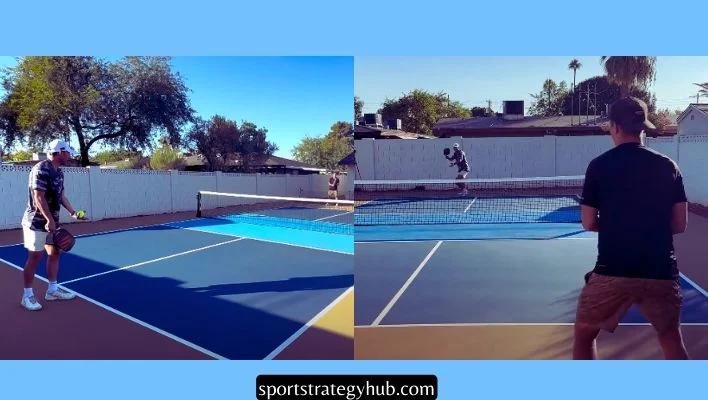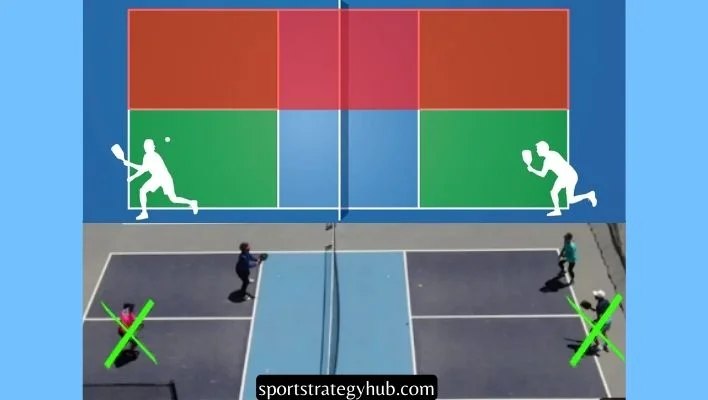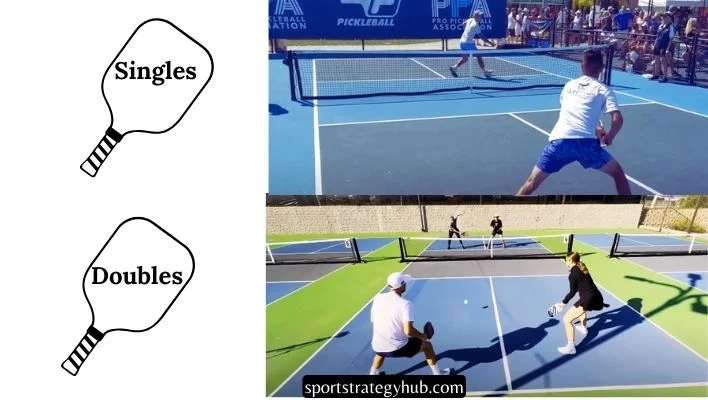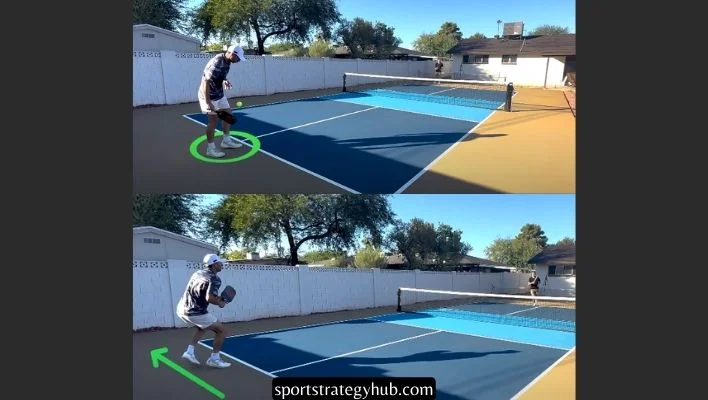How to Play Pickleball Singles: Rules | Player Positioning
Pickleball is a well-liked sport that merges features of tennis, badminton, and ping pong. Although commonly enjoyed as a doubles game, playing pickleball singles offers its own set of challenges and rewards. In this guide, we delve into the rules, techniques, and strategies of how to play pickleball singles effectively. This information is useful whether you are just starting out or have already mastered the basics of the game, as it provides insights into the singular dynamics of playing pickleball alone.
What Is Pickleball, and How Does It Work?
Before we explore the specifics of singles pickleball, let’s first understand the basics of the sport. Pickleball is played on a space comparable to a badminton court, divided by a net at the center. Players wield solid paddles, which can be made of wood or composite materials, to strike a perforated plastic ball across the net. The goal is to score points by playing the ball in a manner that your opponent cannot return it effectively.
The game can be played in doubles format, where each side of the net has two players, or in singles format, with one player per side. Although the fundamental rules are consistent across both formats, there are distinct strategies and dynamics that differentiate singles from doubles pickleball.
See Also: How to play pickleball
What Is a Singles Game Exactly?

In singles pickleball, each side of the court is occupied by just one player. This means that you must cover the entire court by yourself, without a partner to rely on. The dynamics of singles pickleball are slightly different from doubles, as you have more space to cover and must be strategic in your shot placement.
While singles pickleball can be physically demanding, it is also a great opportunity to showcase your individual skills and compete against other players one-on-one. The game is more akin to tennis in terms of court coverage, requiring quick reactions and agility to cover the entire court effectively.
What is Skinny Singles?

In addition to traditional singles pickleball, there is a variation called “skinny singles.” Skinny singles reduce the court to half its size, simplifying movement during one-on-one play. Players can choose to split the court down the middle or use the diagonal service courts for the game.
Skinny singles is a unique way to play singles pickleball, as it combines elements of doubles play with the individual challenge of singles. It allows players to focus on specific skills and strategies while still enjoying the competitive nature of the game.
What’s the Difference between a Singles and Doubles Game?

While both singles and doubles pickleball share the same basic rules and objectives, there are some key differences between the two formats. Understanding these differences will help you adapt your strategy and gameplay when transitioning from doubles to singles or vice versa.In doubles pickleball, you have a partner to communicate and coordinate with, allowing you to cover more ground and execute strategic plays. Doubles games often involve more teamwork, with players setting each other up for shots and working together to control the pace of the game.
In singles pickleball, you alone must cover your side of the court. This means you must be more agile, anticipate your opponent’s shots, and make quick reactions to cover the entire court effectively. Singles play requires a higher level of fitness and stamina, as you will be constantly moving and engaging in longer rallies.
Another distinction between singles and doubles pickleball lies in court positioning. In doubles, players typically start at the baseline and move forward to the non-volley zone (also known as the kitchen) to engage in close-range exchanges. In singles, players generally stay closer to the baseline to cover more ground and have a wider range of shot options.
Understanding these differences will help you adjust your gameplay and strategy when transitioning between singles and doubles pickleball.
See Also: How Long is a Pickleball Game
Understanding Pickleball Singles Rules
To play pickleball singles effectively, it’s essential to familiarize yourself with the specific rules that apply to singles matches. While many rules are the same as doubles pickleball, there are some key differences that you need to be aware of.
Serving Rules for Singles
Serving in singles pickleball adheres to particular rules. Each player initiates their first serve from the right-hand side of the court. If the server scores on this serve, they move to the left-hand side for the subsequent serve. The server continues to alternate between the right and left sides until they fault, at which point the serve goes to the opponent.
It’s important to remember that the server’s score determines which side of the court they serve from. If the server has an even score, they serve from the right side; with an odd score, they serve from the left side. This serves as a simple guide to keep track of the serving sequence throughout the match.
Scoring Rules for Singles
Scoring in singles pickleball is straightforward compared to doubles, as there’s no need for a third number to identify the serving team. In singles, the score format includes two numbers, announcing the server’s score first. To win, a player must reach 11 points and lead by at least two points. The scoring format remains the same as doubles pickleball, where only the serving player can score points.
To keep track of the score, it’s helpful to remember the serving side rule. If the server has an even score, they serve from the court’s right side; if their score is odd, they serve from the left side. This correlation between the serving side and the score makes it easier to determine the correct score during the match.
Faults and Violations Specific to Singles Play
Just as in doubles pickleball, playing singles comes with its own faults and rule violations. Some typical mistakes unique to singles include stepping into or onto the non-volley zone (often called the kitchen) during a volley, sending the ball out of bounds, returning the ball before it bounces, and interfering with an opponent’s shot.
It’s vital to learn these rules thoroughly to avoid making these errors during a game. A good understanding of the rules not only promotes fair play but also enhances the enjoyment of the game for both participants.
Player Positioning for Singles Pickleball

Player positioning is crucial in singles pickleball, as you are solely responsible for covering your side of the court. Proper positioning enables you to move swiftly and respond promptly to your opponent’s plays. Here are some key tips for positioning yourself effectively in singles play:
- Start at the baseline: Begin each point at the baseline to give yourself ample space to react to your opponent’s shots.
- Stay closer to the centerline: Position yourself slightly closer to the centerline to have better access to both sides of the court. This enables you to cover a wider area and reduce the distance you need to move to reach shots.
- Maintain a defensive stance: Maintain balance and readiness to move in any direction. This approach will help you quickly respond to your opponent’s shots and keep control of the court.
- Be prepared for cross-court shots: Anticipate that your opponent may hit shots diagonally across the court. Be ready to move laterally to cover these shots effectively.
- Use the entire court: As the sole player on your side, make use of the entire court to force your opponent to move and create openings for winning shots.
- Adjust your positioning based on your opponent’s tendencies: Observe your opponent’s playing style and adjust your positioning accordingly. If they consistently favor their forehand, position yourself to exploit their weaker backhand side.
By following these positioning strategies, you can maximize your court coverage and improve your chances of winning points in singles pickleball.
How Is a Singles Pickleball Game Played?
Now that you have a good understanding of the rules and strategies for singles pickleball, let’s walk through the step-by-step process of playing a singles match.
- Determine the serving order: Employ a conventional method like a coin toss to decide who serves first. The winner of the toss then serves first.
- Start serving from the right side: The initial serve is executed from the right-hand side of the court. Should the server win the rally or score an ace, they keep serving, switching to the left side for the subsequent serve.
- Alternate serving sides: The server alternates serving from the right and left sides until they either lose the rally or commit a fault. At that point, a side-out occurs, and the opponent becomes the server.
- Keep track of the score: Remember that the server’s score determines which side they serve from. When the server’s score is even, they serve from the right side; when it’s odd, they serve from the left side.
- Rally back and forth: After the serve, the players engage in a rally, hitting the ball back and forth over the net. According to the double bounce rule, both players are required to let the ball bounce once before returning it.
- Earn points: Only the serving player can score points. To earn a point, the serving player must win a rally, with the opponent failing to return the ball successfully.
- Continue playing until a player reaches 11 points: The game goes on until a player scores 11 points and leads by at least two points. This player is then declared the winner of the game.
Following these steps will guide you through a singles pickleball match, ensuring fair play and an enjoyable experience for both players.
Frequently Asked Questions
The court dimensions for singles pickleball are identical to those for doubles, measuring 20 feet in width and 44 feet in length, with the net centrally positioned.
The serving guidelines for singles and doubles pickleball are largely identical. The main difference is that in singles, there is no concept of server #1 or server #2, as there is in doubles.
Switching from singles to doubles play mid-game is uncommon. Singles and doubles are distinct formats of pickleball, and players typically choose one format for the entire match.
In pickleball, both singles and doubles matches follow the “two-bounce” rule. This rule requires each player or team to allow the ball to bounce once on their side of the net before striking it. Once the ball has completed its two bounces, players have the option to volley it or allow it to bounce again before returning it.
No, there are no separate singles lines on a pickleball court. The court dimensions for singles and doubles play are the same, and the lines demarcating the court remain the same for both formats.
Conclusion
Engaging in pickleball singles provides players of every skill level with a distinctive and demanding experience. By following the specific rules and strategies for singles play, you can enhance your pickleball skills and enjoy the thrill of competing one-on-one. Remember to focus on positioning, adapt your strategies, and maintain a competitive spirit throughout the match. Whether you’re a doubles player looking to try singles or a newcomer to the sport, singles pickleball is a fantastic way to improve your game and have fun on the court.
